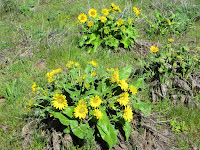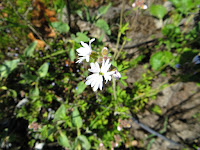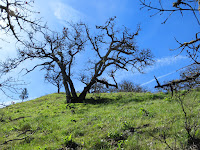Freeway driving, especially when on cruise control, frees up the mind just a bit to rifle through a sample of life's petty puzzlements. Mental analysis mixed with vista viewing make the journey pass quickly and then suddenly I'm there. The Tom McCall Preserve, five miles west of The Dalles and high on the basalt bluffs between Mosier and Rowena.
A clear blue sky lets all of the rising sun's rays fall on the greening landscape. The layers of lava flow from ages gone by, looking like a vertically ribbed chocolate wedding cake, pile one on another and are topped by a green frosting of velvet-looking spring grass. This verdant covering will quickly dry to a boring beige once the hot winds and low moisture of summer arrive, but for now it gives a soft fuzzy look to the terrain. Carving a wide, azure path between towering sides of this coulee, the Columbia quietly surges to the sea, deepened by the 14 dams on it in Canada, Washington and Oregon. Tiny barges and boats cut slick watery trails as they carry their wares up and down the river. Birds slowly spiral in the thermals near the cliffs, spying out tasty critters far below.
The Preserve is perched along the Old Columbia River Highway, a narrow serpentine cement pathway between Troutdale and The Dalles, a 75 mile stretch of curves and views and branded as the scenic route. It cuts through orchards just budding out, through minuscule towns and past aged dwellings that house the migrant workers of this place. Below it races the Interstate traffic intent on making fast times to various destinations. The scenic course is comparatively slow, but that allows for a stop to watch workers on tall ladders prune apple and pear trees, and a pull-out to contemplate a striking view of the Gorge.
Arriving at the Preserve, I see a few hikers already ascending the trail with backpacks in order and cameras and tripods clutched in eager search of this season's wildflower display. Other visitors are merely peering over the arched railing into the deep ravine below, listening to the report of target shooting echoing between the two great walls of rock. They who drive and dash miss the exquisite beauty of this place. They take a selfie or two with a vague background of the majestic scenery and quickly move on to the next point of interest. Three female deer slowly snack their way across the far field, oblivious to the view but keeping a wary eye on the humans who have spotted them.
 |
| Balsomroot |
Turning to catch the view, I spy the top of Mt. Adams peeking above the northern hills on the Washington side like a snowman's hat. More of the river can be seen now as it curves east toward The Dalles dam and rounds the bend west toward Bonneville dam. A slight breeze transports cooling air to the back of my neck as the exertion of climbing brings on a coat of perspiration. Scrub oak, still in the lock of dormancy, splay their bare branches against the cloudless sky, offering only the shade from their trunks today.
Varieties of desert parsley in magenta and bright yellow begin to appear, clumping among the rocks and rooting in the barest of soil, tenacious in their return every year. Their gray-green fringy leafage gives background to the tall spikes of umbel flower heads. Columbia desert parsley, Lomatium columbianum, is uncommon elsewhere but seen in proliferation here. On the lookout for the itchy, oily leaves of poison oak I notice the early red leafing of a tiny lone branch. Peering more closely I see it is all around me, reaching out with those attractively colored bunches of three leaves, so innocent in its youth. Soon it will be raging bushes of maroon madness, luring the unschooled into its clutches. Step cautiously dear hikers!
 |
| Fawn lilies |
Thoughts of pioneers and explorers fill my head and I wonder at their tough commitment to reach a dreamed of destination. My grandmother and her parents came from The Dalles in a covered wagon. What did they think when they saw this grand canyon of the Pacific Northwest, its rich valleys awaiting orchards and farms, its waters pure and mountain fresh. How did they survive in those first years, waiting for crops to mature, scrapping for a livelihood and living off the land. Only their diaries and letters ever told the tale; only their tumbling down homesteads give a hint at their perseverance. Perhaps the gift of wildflowers gave them bouquets of enjoyment as they planted their apple and pear saplings. It is the wildflowers that are free to anyone taking the trip to the Preserve. Hurry as they wait for no one. Now is the time catch the blooms!
 |
| Pruning time! |
 |
| Apple trees in early bloom |
 |
| Deer at the Preserve |
 |
| Desert parsley in yellow |
 |
| Up river |
 |
| View to the summit |
 |
| Clean those boots! |
 |
| Small pond on the plateau |
 |
| Larkspur |
 |
| Lupine readying for bloom |
 |
| Widow grass |
 |
| Fawn lily |
 |
| Wild onion |
 |
| Shooting star |
 |
| Columbia desert parsley |
 |
 |
| Field of balsomroot |
 |
| Poison oak beginning to show |
 |
 |
| Wild geranium type |
 |
| Keep climbing! |
 |
| Yellow bell |
 |
| Yellow bell before opening |
 |
| Indian paintbrush |
 |
| Old Columbia River Highway |
 |
| Mt. Adams |
 |
| Scrub oak watches over the valley |
 |
| Desert parsley takes root wherever it can |


Fantastic pictures and story.
ReplyDelete